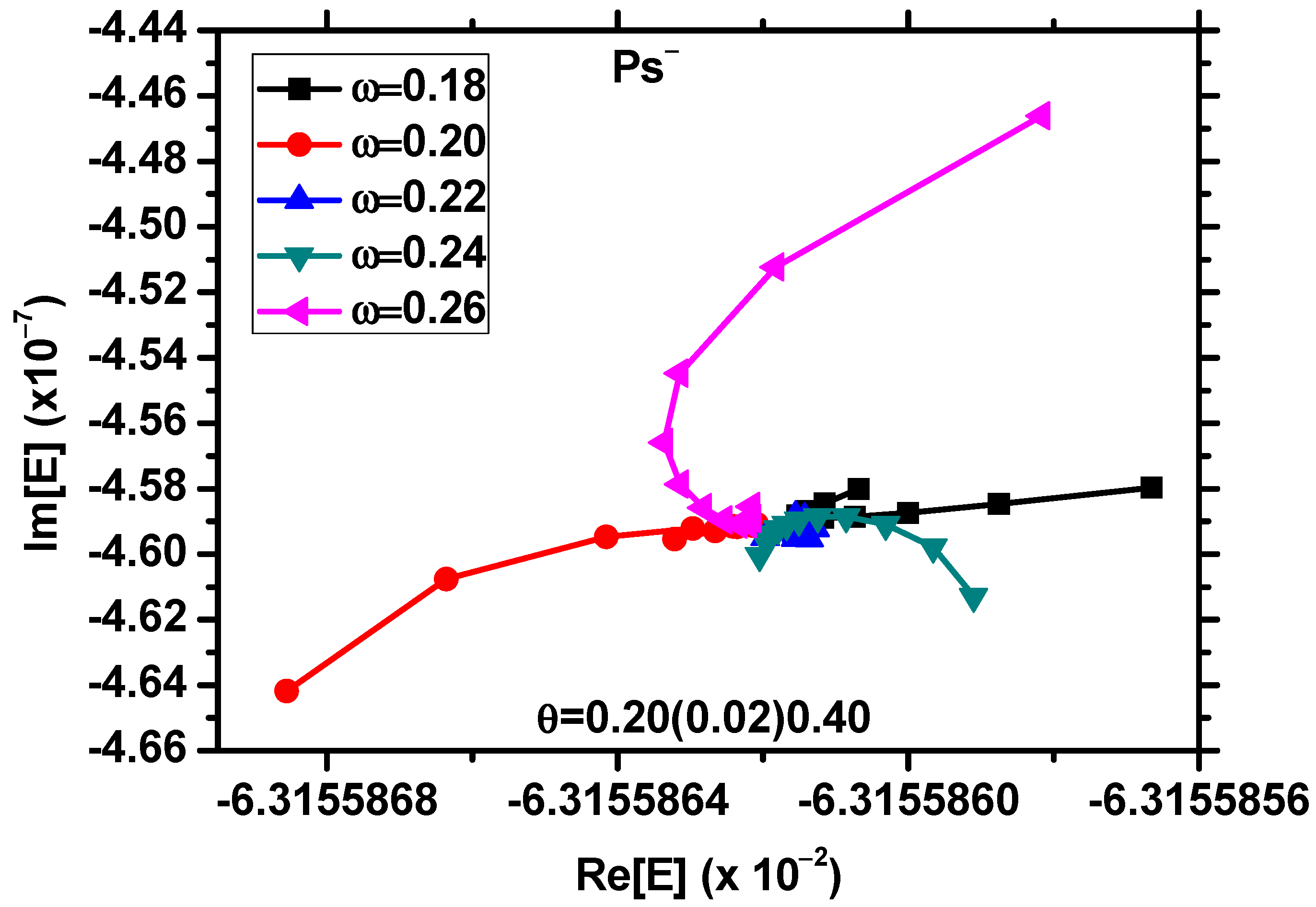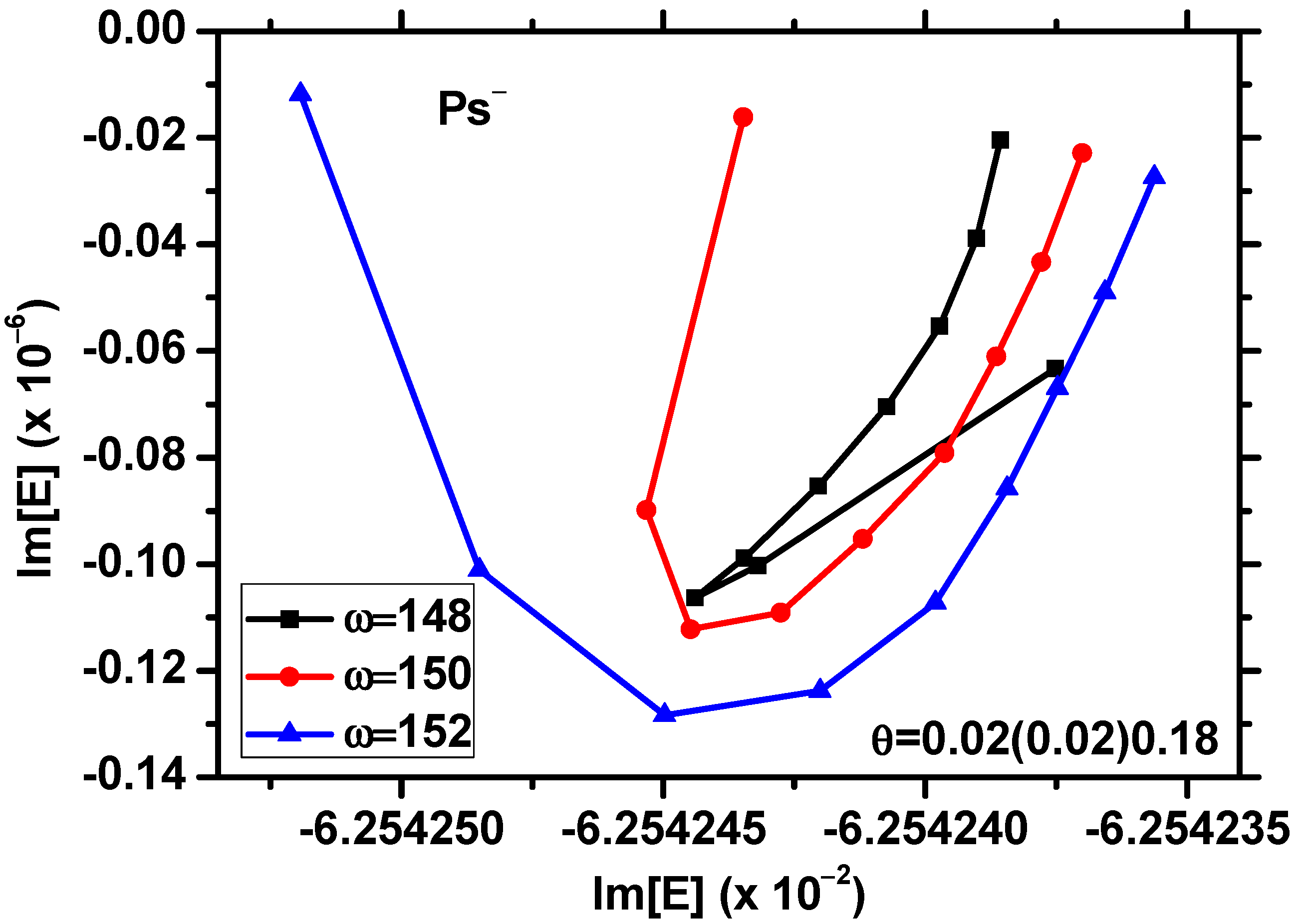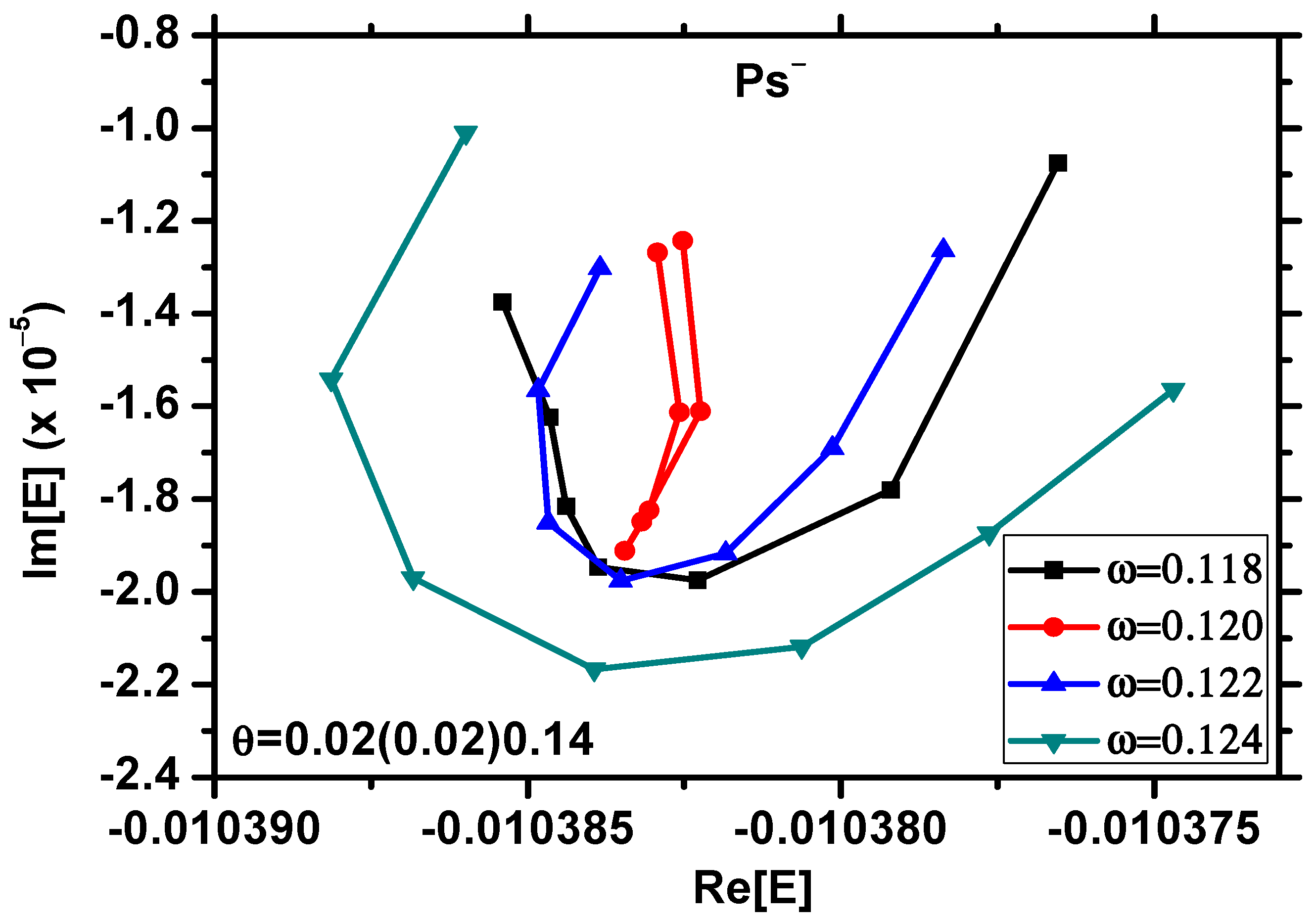Calculations of Resonance Parameters for the Doubly Excited 1P° States in Ps− Using Exponentially Correlated Wave Functions
Abstract
:1. Introduction
2. Theory
3. Results and Discussions
4. Conclusions
Author Contributions
Funding
Conflicts of Interest
References
- Michishio, K.; Kanai, T.; Kuma, S.; Azuma, T.; Wada, K.; Mochizuki, I.; Hyodo, T.; Yagishita, A.; Nagashima, Y. Observation of a shape resonance of the positronium negative ion. Nat. Commun. 2016, 7, 11060. [Google Scholar] [CrossRef] [PubMed] [Green Version]
- Wheeler, J.A. Polyelectrons. Ann. N. Y. Acad. Sci. 1946, 48, 219–238. [Google Scholar] [CrossRef]
- Hylleraas, E.A. Electron affinity of positronium. Phys. Rev. 1947, 71, 491. [Google Scholar] [CrossRef]
- Mills, A.P., Jr. Observation of the positronium negative ion. Phys. Rev. Lett. 1981, 46, 717. [Google Scholar] [CrossRef]
- Mills, A.P., Jr. Measurement of the decay rate of the positronium negative ion. Phys. Rev. Lett. 1983, 50, 671. [Google Scholar] [CrossRef]
- Rost, J.M.; Wingten, D. Positronium negative ion: Molecule or atom? Phys. Rev. Lett. 1992, 69, 2499. [Google Scholar] [CrossRef]
- Ivanov, I.A.; Ho, Y.K. Supermultiplet structures of the doubly excited positronium negative ion. Phys. Rev. A 2000, 61, 032501. [Google Scholar] [CrossRef]
- Ho, Y.K. Atomic resonances involving positrons. Nucl. Instrum. Method Phys. Res. B 2008, 266, 516–521. [Google Scholar] [CrossRef]
- Michishio, K.; Tachibana, T.; Terabe, H.; Igarashi, A.; Wada, K.; Kuga, T.; Yagishita, A.; Hyodo, T.; Nagashima, Y. Photodetachment of positronium negative ions. Phys. Rev. Lett. 2011, 106, 153401. [Google Scholar] [CrossRef]
- Nagashima, Y. Experiments on positronium negative ions. Phys. Rep. 2014, 545, 95–123. [Google Scholar] [CrossRef]
- Kar, S.; Ho, Y.K. Excitons and the positronium negative ion: comparison in spectroscopic properties. In Excitons; Pyshkin, S.L., Ed.; INTECH: London, UK, 2018; Chapter 5; pp. 69–90. [Google Scholar]
- Kar, S.; Ho, Y.K. A new 1P° shape resonance in Ps− above the Ps (N = 3) threshold. Phys. Lett. A 2018, 382, 1787–1790. [Google Scholar] [CrossRef]
- Kar, S.; Ho, Y.K. Two-photon double-electron D-wave resonant excitation in the positronium negative ion. Eur. Phys. J. D 2018, 72, 193. [Google Scholar] [CrossRef]
- Cassidy, D.B. Experimental progress in positronium laser physics. Eur. Phys. J. D 2018, 72, 53. [Google Scholar] [CrossRef] [Green Version]
- Kar, S.; Wang, Y.S.; Wang, Y.; Ho, Y.K. Polarizability of negatively charged helium-like ions interacting with Coulomb and screened Coulomb potentials. Int. J. Quantum Chem. 2018, 118, e25515. [Google Scholar] [CrossRef]
- Kar, S.; Wang, Y.S.; Wang, Y.; Ho, Y.K. Critical stability of the negatively charged positronium like ions with Yukawa potentials and varying Z. Atoms 2019, 7, 53. [Google Scholar] [CrossRef] [Green Version]
- Ho, Y.K. Autoionization states of the positronium negative ion. Phys. Rev. A 1979, 19, 2347. [Google Scholar] [CrossRef]
- Botero, J. Adiabatic study of the positronium negative ion. Phys. Rev. A 1987, 35, 36–50. [Google Scholar] [CrossRef]
- Bhatia, A.K.; Ho, Y.K. Complex-coordinate calculation of 1,3P resonances in Ps− using Hylleraas functions. Phys. Rev. A 1990, 42, 1119–1122. [Google Scholar] [CrossRef]
- Ho, Y.K.; Bhatia, A.K. 1,3P° resonance states in positronium ions. Phys. Rev. A 1991, 44, 2890–2894. [Google Scholar] [CrossRef]
- Kar, S.; Ho, Y.K. Doubly excited 1,3P° resonance states of Ps− in weakly coupled plasmas. Phys. Rev. A 2006, 73, 032502. [Google Scholar] [CrossRef]
- Igarashi, A.; Shimamura, I.; Toshima, N. Photodetachment cross sections of the positronium negative ion. New J. Phys. 2000, 2, 17. [Google Scholar] [CrossRef]
- Ho, Y.K.; Bhatia, A.K. P–wave shape resonances in positronium ions. Phys. Rev. A 1993, 47, 1497–1499. [Google Scholar] [CrossRef] [PubMed]
- Hu, C.-Y.; Kvitsinsky, A.A. Resonances in e−-Ps elastic scattering via a direct solution of the three-body scattering problem. Phys. Rev. A 1994, 50, 1924–1926. [Google Scholar] [CrossRef] [PubMed]
- Kar, S.; Ho, Y.K. The 1,3D° resonance states of positronium negative ion using exponential correlated wave functions. Eur. Phys. J. D 2010, 57, 13–19. [Google Scholar] [CrossRef]
- Kar, S.; Ho, Y.K. Resonance states of Ps− using correlated wave functions. Comput. Phys. Commun. 2011, 181, 119–121. [Google Scholar] [CrossRef]
- Ward, S.J.; Humberston, J.W.; McDowell, M.R.C. Elastic scattering of electrons (or positrons) from positronium and the photodetachment of the positronium negative ion. J. Phys. B 1987, 20, 127–149. [Google Scholar] [CrossRef]
- Botero, J.; Greene, C.H. Resonant photodetachment of the positronium negative ion. Phys. Rev. Lett. 1986, 56, 1366–1369. [Google Scholar] [CrossRef]
- Botero, J. Adiabatic hyperspherical study of three-particle systems. Z. Phys. D 1988, 8, 177–180. [Google Scholar] [CrossRef]
- Zhou, Y.; Lin, C.D. Comparative Studies of Excitations and Resonances in H−, Ps−, and e+ + H Systems. Phys. Rev. Lett. 1995, 75, 2296. [Google Scholar] [CrossRef]
- Igarashi, A.; Shimamura, I. Time-delay matrix analysis of resonances: Application to the positronium negative ion. J. Phys. B 2004, 37, 4221. [Google Scholar] [CrossRef] [Green Version]
- Aiba, K.; Igarashi, A.; Shimamura, I. Time-delay matrix analysis of several overlapping resonances: Applications to the helium atom and the positronium negative ion. J. Phys. B 2007, 40, F9–F17. [Google Scholar] [CrossRef]
- Ho, Y.K. The method of complex coordinate rotation and its applications to atomic collision processes. Phys. Rep. 1983, 99, 1–68. [Google Scholar] [CrossRef]
- Kar, S.; Ho, Y.K. Positron annihilation in plasma-embedded Ps−. Chem. Phys. Lett. 2006, 424, 403–408. [Google Scholar] [CrossRef]
- Mohr, P.J.; Newell, D.B.; Taylor, B.N. CODATA Recommended Values of the Fundamental Physical Constants: 2014*. J. Phys. Chem. Ref. Data 2016, 45, 043102. [Google Scholar] [CrossRef] [Green Version]





| Present Calculations | Other Calculations | ||||
|---|---|---|---|---|---|
| Reference | |||||
| N = 2: Eth = −0.0625 | |||||
| 1P° (1) | −0.063155862(2) | 0.459(1) × 10−6 | −0.0631553(1.5) −0.0631559 −0.063155 −0.0625087 | 0.5(1.5) × 10−6 0.4435 × 10−6 0.41 × 10−6 | a b c d |
| 1P° (2) | −0.06254244(4) | 0.11(3) × 10−6 | −0.062543 | 0.125 × 10−6 | c |
| 1P° (shape) | −0.06218(2) | 0.00020(2) | −0.06217(1.5) | 0.000225(1.5) | e |
| −0.062158 | 0.00032 | c | |||
| N = 3: Eth = −0.0277777777778 | |||||
| 1P° (1) | −0.03162236(2) | 0.0001103(2) | −0.03162235(0.5) | 0.0001103(0.5) | a |
| −0.031621 | 0.00011 | c | |||
| 1P° (2) | −0.02921495(2) | 0.75(2) × 10−6 | −0.02921495(0.5) | 0.75(0.5) × 10−6 | a |
| −0.029212 | 0.75 × 10−6 | c | |||
| 1P° (3) | −0.0281276(1) | 0.33(3) × 10−6 | −0.028125 | 0.30 × 10−6 | c |
| 1P° (4) | −0.0281013(1) | 0.169(2) × 10−4 | −0.028099 | 0.165 × 10−4 | c |
| 1P° (5) | −0.027863(1) | 0.2(1) × 10−6 | −0.027864 | 0.435 × 10−7 | c |
| 1P° (6) | −0.027809(2) | 0.28(3) × 10−5 | −0.027811 | 0.175 × 10−5 | c |
| 1P° (shape) | −0.0255(2) | 0.0021(2) | f | ||
| N = 4: Eth = −0.015625 | |||||
| 1P° (1) | −0.01889032(1) | 0.0000154 | −0.01889035(0.5) | 0.0000154(0.5) | g |
| −0.018890385(1) | 0.000015395 | h | |||
| −0.018863 | 0.000016 | c | |||
| 1P° (2) | −0.01704109(1) | 0.8(2) × 10−6 | −0.01704125(0.5) | 0.65 × 10−6 | g |
| −0.017031 | 0.55 × 10−6 | c | |||
| 1P° (3) | −0.016536(2) | 0.10(2) × 10−4 | −0.0165385(0.5) | 0.098(0.5) × 10−4 | g |
| −0.016480 | 0.1 × 10−4 | ||||
| 1P° (4) | −0.016163(1) | 0.2(1) × 10−5 | −0.016161(2.5) | 0.235(2.5) × 10−5 | g |
| −0.016139 | 0.21 × 10−6 | c | |||
| 1P° (5) | −0.015882(2) | 0.20(2) × 10−4 | −0.015880 (2.5) | 0.085(2.5) × 10−4 | g |
| −0.015855 | 0.32 × 10−5 | c | |||
| 1P° (6) | −0.015802(1) | 0.10(1) × 10−5 | −0.0158025(1) | 0.125(1) × 10−5 | g |
| −0.015819 | 0.65 × 10−7 | c | |||
| 1P° (7) | −0.01566(2) | 0.035(3) × 10−5 | |||
| 1P° (shape) | −0.01548(1) | 0.000022(2) | −0.0154875(0.5) | 0.000015(0.5) | e |
| −0.0154775(1.5) | 0.0000305 | h | |||
| N = 5: Eth = −0.01 | |||||
| 1P° (1) | −0.012463(2) | 0.16(2) × 10−4 | −0.0124625(0.5) | 0.1525(5) × 10−4 | g |
| −0.01246295 | 0.1525 × 10−4 | h | |||
| 1P° (2) | −0.011216(1) | 0.2(1) × 10−5 | −0.0112155(2.5) | 0.135 × 10−5 | g |
| 1P° (3) | −0.01104(1) | 0.22(1) × 10−4 | −0.01104375(0.5) | 0.1575(0.5) × 10−4 | g |
| 1P° (4) | −0.01083(2) | 0.70(2) × 10−4 | −0.010830(0.5) | 0.68(0.5) × 10−4 | g |
| −0.01083009(1.5) | 0.68045 × 10−4 | h | |||
| 1P° (5) | −0.010580(3) | 0.16(3) × 10−4 | |||
| 1P° (6) | −0.01048(1) | 0.2(1) × 10−4 | |||
| 1P° (7) | −0.010384(3) | 0.19(3) × 10−4 | |||
| 1P° (8) | −0.01022(1) | 0.7(1) × 10−4 | |||
| Present Calculations | ||
|---|---|---|
| (meV) | ||
| N = 2 | ||
| 1P° (1) | 5.4109623645 | 0.024980052 |
| 1P° (2) | 5.4276543 | 0.0060 |
| 1P° (shape) | 5.43752 | 10.88456 |
| 5.437(1) a | 10(2) a | |
| N = 3 | ||
| 1P° (1) | 6.26903263 | 6.002832 |
| 1P° (2) | 6.33454159 | 0.0408 |
| 1P° (3) | 6.36412989 | 0.01796 |
| 1P° (4) | 6.36484555 | 0.9198 |
| 1P° (5) | 6.37133002 | 0.0109 |
| 1P° (6) | 6.372799 | 0.1524 |
| 1P° (shape) | 6.4356 b | 114.29 b |
| N = 4 | ||
| 1P° (1) | 6.61548907 | 0.83811 |
| 1P° (2) | 6.66580918 | 0.0436 |
| 1P° (3) | 6.6795534 | 0.544 |
| 1P° (4) | 6.6897032 | 0.108 |
| 1P° (5) | 6.6973496 | 1.088 |
| 1P° (6) | 6.6995265 | 0.0544 |
| 1P° (7) | 6.70339 | 1.9048 |
| 1P° (shape) | 6.70829 | 1.198 |
| N = 5 | ||
| 1P° (1) | 6.790385 | 0.0870 |
| 1P° (2) | 6.824318 | 0.108 |
| 1P° (3) | 6.829107 | 1.20 |
| 1P° (4) | 6.834822 | 3.810 |
| 1P° (5) | 6.841624 | 0.870 |
| 1P° (6) | 6.844346 | 1.08 |
| 1P° (7) | 6.846958 | 1.034 |
| 1P° (8) | 6.85142 | 3.80 |
© 2019 by the authors. Licensee MDPI, Basel, Switzerland. This article is an open access article distributed under the terms and conditions of the Creative Commons Attribution (CC BY) license (http://creativecommons.org/licenses/by/4.0/).
Share and Cite
Kar, S.; Ho, Y.K. Calculations of Resonance Parameters for the Doubly Excited 1P° States in Ps− Using Exponentially Correlated Wave Functions. Atoms 2020, 8, 1. https://doi.org/10.3390/atoms8010001
Kar S, Ho YK. Calculations of Resonance Parameters for the Doubly Excited 1P° States in Ps− Using Exponentially Correlated Wave Functions. Atoms. 2020; 8(1):1. https://doi.org/10.3390/atoms8010001
Chicago/Turabian StyleKar, Sabyasachi, and Yew Kam Ho. 2020. "Calculations of Resonance Parameters for the Doubly Excited 1P° States in Ps− Using Exponentially Correlated Wave Functions" Atoms 8, no. 1: 1. https://doi.org/10.3390/atoms8010001






